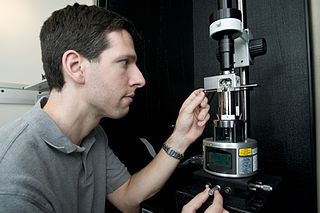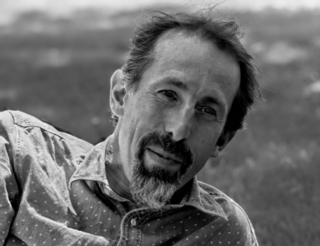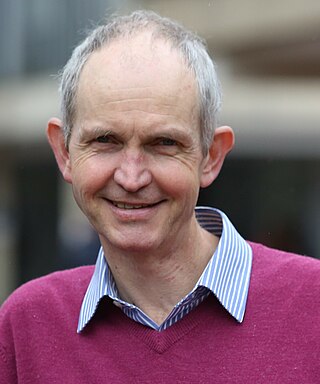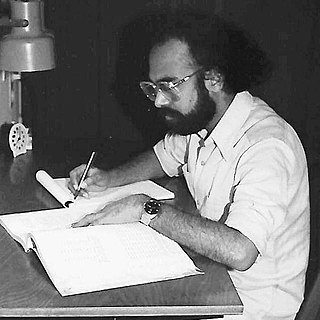Related Research Articles

In physics, polaritons are quasiparticles resulting from strong coupling of electromagnetic waves with an electric or magnetic dipole-carrying excitation. They are an expression of the common quantum phenomenon known as level repulsion, also known as the avoided crossing principle. Polaritons describe the crossing of the dispersion of light with any interacting resonance. To this extent polaritons can also be thought of as the new normal modes of a given material or structure arising from the strong coupling of the bare modes, which are the photon and the dipolar oscillation. The polariton is a bosonic quasiparticle, and should not be confused with the polaron, which is an electron plus an attached phonon cloud.
The Abraham–Minkowski controversy is a physics debate concerning electromagnetic momentum within dielectric media. Two equations were first suggested by Hermann Minkowski (1908) and Max Abraham (1909) for this momentum. They predict different values, from which the name of the controversy derives. Experimental support has been claimed for both.

Lene Vestergaard Hau is a Danish physicist and educator. She is the Mallinckrodt Professor of Physics and of Applied Physics at Harvard University.
In condensed matter physics, Anderson localization is the absence of diffusion of waves in a disordered medium. This phenomenon is named after the American physicist P. W. Anderson, who was the first to suggest that electron localization is possible in a lattice potential, provided that the degree of randomness (disorder) in the lattice is sufficiently large, as can be realized for example in a semiconductor with impurities or defects.
Atom optics is the area of physics which deals with beams of cold, slowly moving neutral atoms, as a special case of a particle beam. Like an optical beam, the atomic beam may exhibit diffraction and interference, and can be focused with a Fresnel zone plate or a concave atomic mirror. Several scientific groups work in this field.

The atomic de Broglie microscope is an imaging system which is expected to provide resolution at the nanometer scale. It is sometimes referred to as a "nanoscope."
Diffusing-wave spectroscopy (DWS) is an optical technique derived from dynamic light scattering (DLS) that studies the dynamics of scattered light in the limit of strong multiple scattering. It has been widely used in the past to study colloidal suspensions, emulsions, foams, gels, biological media and other forms of soft matter. If carefully calibrated, DWS allows the quantitative measurement of microscopic motion in a soft material, from which the rheological properties of the complex medium can be extracted via the microrheology approach.

A photonic metamaterial (PM), also known as an optical metamaterial, is a type of electromagnetic metamaterial, that interacts with light, covering terahertz (THz), infrared (IR) or visible wavelengths. The materials employ a periodic, cellular structure.

Robert William Boyd is an American physicist noted for his work in optical physics and especially in nonlinear optics. He is currently the Canada Excellence Research Chair Laureate in Quantum Nonlinear Optics based at the University of Ottawa, Professor of Physics cross-appointed to the School of Electrical Engineering and Computer Science at the University of Ottawa, and Professor of Optics and Professor of Physics at the University of Rochester.
Photonic molecules are a theoretical natural form of matter which can also be made artificially in which photons bind together to form "molecules". They were first predicted in 2007. Photonic molecules are formed when individual (massless) photons "interact with each other so strongly that they act as though they have mass". In an alternative definition, photons confined to two or more coupled optical cavities also reproduce the physics of interacting atomic energy levels, and have been termed as photonic molecules.
Ortwin Hess is a German-born theoretical physicist at Trinity College Dublin (Ireland) and Imperial College London (UK), working in condensed matter optics. Bridging condensed matter theory and quantum optics he specialises in quantum nanophotonics, plasmonics, metamaterials and semiconductor laser dynamics. Since the late 1980s he has been an author and coauthor of over 300 peer-reviewed articles, the most popular of which, called "'Trapped rainbow' storage of light in metamaterials", was cited more than 400 times. He pioneered active nanoplasmonics and metamaterials with quantum gain and in 2014 he introduced the "stopped-light lasing" principle as a novel route to cavity-free (nano-) lasing and localisation of amplified surface plasmon polaritons, giving him an h-index of 33.

Nicolas Gisin is a Swiss physicist and professor at the University of Geneva working on the foundations of quantum mechanics, and quantum information and communication. His work includes both experimental and theoretical physics. He contributed work in the fields of experimental quantum cryptography and long distance quantum communication in standard telecom optical fibers. He co-founded ID Quantique, a spin-off company that provides quantum-based technologies.
Hyperuniform materials are mixed-component many-particle systems with unusually low fluctuations in component density at large scales, when compared to the distribution of constituents in common disordered systems, like a mixed ideal gas (air) or typical liquids or amorphous solids: A disordered hyperuniform system is statistically isotropic, like a liquid, but exhibits reduced long-wavelength density fluctuations, similar to crystals.

Jeremy John Baumberg, is Professor of Nanoscience in the Cavendish Laboratory at the University of Cambridge, a Fellow of Jesus College, Cambridge and Director of the NanoPhotonics Centre.

The Adolphe Merkle Institute (AMI) is a research center in Fribourg, Switzerland focused on nanoscience. The institute is named after the Swiss entrepreneur Adolphe Merkle who created the foundation that partially funded the institute.

Jonathan C. Knight, is a British physicist. He is the Pro Vice-Chancellor (Research) for the University of Bath where he has been Professor in the Department of Physics since 2000, and served as head of department. From 2005 to 2008, he was founding Director of the university's Centre for Photonics and Photonic Materials.

Choi Wonshik is an optical physicist researching deep-tissue imaging and imaging through scattering media. He is a full professor in the Department of Physics of Korea University where he serves as the associate director at the IBS Center for Molecular Spectroscopy and Dynamics. Inside the Center, he leads the Super-depth Imaging Lab. He has been cited more than 4,000 times and has an h-index of 32. He is a fellow of The Optical Society.
Jonathan James Finley is a Professor of Physics at the Technical University of Munich in Garching, Germany, where he holds the Chair of Semiconductor Nanostructures and Quantum Systems. His focus is on quantum phenomena in semiconductor nanostructures, photonic materials, dielectric and metallic films, among others, for applications in quantum technology. At such, he made major contributions to the characterization and understanding of the optical, electronic and spintronic properties of quantum dots and wires both from group-IV and II-VI materials and oxides.

Purushottam Chakraborty is an Indian physicist who is one of the renowned experts in materials analysis using ion beams and secondary ion mass spectrometry (SIMS).
David Leslie Andrews,, is a British scientist appointed as Professor of Chemical Physics at the University of East Anglia, where he was the Head of Chemical Sciences and Physics, from 1996 to 1999.
References
- 1 2 "Soft Matter & Photonics – Department of Physics". University of Fribourg. Retrieved 18 January 2022.
- 1 2 "Frank Scheffold – Department of Physics". University of Fribourg (in French). Retrieved 18 January 2022.
- ↑ Frank Scheffold publications indexed by Google Scholar